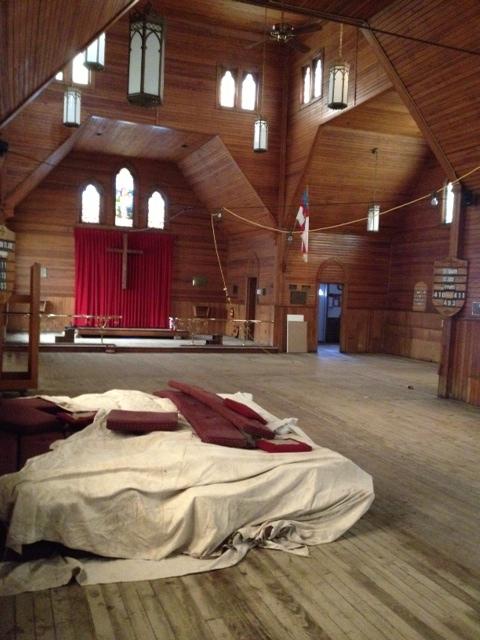A Summer Chapel
Before the framework for the church building was even erected, our first members—"summer people" from Philadelphia, northern New Jersey, and New York—opened their homes for Sunday services. With their numbers growing, these early church members decided in 1888 to purchase our present site at the southwest corner of Howe Street and Lake Avenue for a summer chapel.
The purchase was a success—with the understanding that (among other restrictions) the property would not allow "the sale of intoxicating liquors, the presence of hog pens or stables, nor the establishment of outdoor privies." And that chapel, which is the nave of the present-day All Saints, was completed—for the princely sum of $2,163—in time for the first service on July 7, 1889.
From the outside, you would have seen a small box-like structure (our present-day nave minus the narthex, enclosed bell tower, crossing, sacristy, and most everything else). The transept, crossing, and sanctuary, which would extend the church approximately 45 feet to the east toward Lake Avenue, were added around 1900. The original building stood alone on pilings in the sand and tall grass marshes, against a backdrop of freight cars on the railroad tracks. (See the old photos in Bristol Hall.)
Early on, an iron fence enclosed the church property. Wooden walkways were built for sidewalks on Howe Street and as an approach to the church entrance. And, in the not-yet-enclosed bell tower, a locomotive bell from the Baldwin Locomotive Works in Philadelphia, courtesy of one of our congregants, rang out, calling the faithful to worship. And, those worshipers would have knelt at the same brass altar rail we kneel before today.
The Year-Round Church
At first, All Saints offered Sunday services during July only, gradually expanding the "church year" to Labor Day, and then from Easter to All Saints' Day. Finally, we became a year-round parish in 1984. During the past 125 years, we have been served by many clergy, including several bishops. Perhaps the most impressive of these visiting clergy was The Most Rev. and Rt. Hon. F. Donald Coggan, Archbishop of Canterbury, who officiated on September 4, 1977—wearing shorts and sandals beneath his robe, as many clergy at this seaside parish have done over the years.
One event, though, that put All Saints Church "on the map" was the event that tore the church building from its foundation and destroyed the rectory. On October 29, 2012, the New Jersey coast was slammed by Hurricane Sandy, the second costliest storm in U.S. history. At its deadly height, Sandy raged across Bay Head during a full moon at high tide, bringing with it a storm surge of approximately 13 feet and leaving 24 dead in New Jersey. What remained of the streets was buried beneath several feet of sand, parts of homes and boardwalks, personal belongings, and boats of all sizes.

Eternal Father, Strong to Save
Aptly enough, All Saints’ sanctuary was truly saved by the baptismal font in the narthex, which anchored one end of the sanctuary and its connection to Bristol Hall at the other end. The storm had fiercely battered the church property, causing more than $2 million in damages and scouring out nearly 8 feet of ground around its old brick pilings. This damage caused the floors to sink and compromised the sanctuary walls. Watermarks and debris on the wainscoting suggested the church had been filled with 3 or 4 feet of water. Outside the church, the once charming landscape was buried under 4 feet of sand. Behind the church, the bulkhead had been torn away and with it about 6 feet of land. The rectory, though still intact, was rendered uninhabitable. Amid this devastation, it was difficult to know where to begin the recovery process.
Thanks to the grace of God and the kindness of many, we did recover—restoring our beloved church building and constructing an enitrely new rectory. We are especially grateful to our neighboring Episcopal parish, St. Mary's-by-the-Sea in Point Pleasant Beach, which generously offered us office space and the use of their sanctuary so that we could carry on our parish life. After 14 months "in exile," we returned with joy to celebrate our first service at All Saints Church on December 22, 2013.

